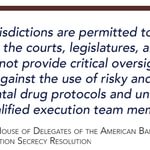Behind the Curtain: Secrecy and the Death Penalty in the United States
Executive Summary Top
During the past seven years, states have begun conducting executions with drugs and drug combinations that have never been tried before. They have done so behind an expanding veil of secrecy laws that shield the execution process from public scrutiny.
As pharmaceutical companies have taken action to prevent states from using their medicines to execute prisoners, states have responded by procuring whatever drugs seem available and obtaining them secretly through questionable means.

Since January 2011, legislatures in thirteen states have enacted new secrecy statutes that conceal vital information about the execution process. Of the seventeen states that have carried out 246 lethal-injection executions between January 1, 2011 and August 31, 2018, all withheld at least some information about the about the execution process. All but one withheld information about the source of their execution drugs. Fourteen states prevented witnesses from seeing at least some part of the execution. Fifteen prevented witnesses from hearing what was happening inside the execution chamber. None of the seventeen allowed witnesses to know when each of the drugs was administered.
This retreat into secrecy has occurred at the same time that states have conducted some of the most problematic executions in American history. Lethal injection was supposed to be a more humane method of execution than hanging, the firing squad, or the electric chair, but there have been frequent reports of prisoners who were still awake and apparently experiencing suffocation and excruciating pain after they were supposed to be insensate. These problems have intensified with the use of new drug formulas, often including midazolam. In 2017, more than 60% of the executions carried out with midazolam produced eyewitness reports of an execution gone amiss, with problems ranging from labored breathing to gasping, heaving, writhing, and clenched fists. In several of these cases, state officials denied that the execution was problematic, asserting that all had proceeded according to protocol. But without access to information about drugs and the execution process, there is no way the public can judge for itself.
Disturbing stories of botched executions are just one sign of the need for public scrutiny of lethal injection. Investigators who have managed to uncover hidden information have found evidence of illegal actions, misrepresentations to the courts and the public, and incompetence in the conduct of executions. States have repeatedly tried to conceal controversial information about executions, including the use of illegally imported drugs, less than reputable drug sources, and unqualified executioners. Without transparency, cases of incompetence or misconduct can continue unchecked.

Governmental transparency is fundamental to democracy. The public has a right to know how its government is carrying out its business and whether the government is working honestly and competently, by and for the People. The Eighth Amendment requires that punishments imposed by the government conform to public standards of decency, but this is impossible to determine if crucial information about a punishment is kept from the public.
Secrecy increases the risk of problems. It results in more botched and potentially problematic executions. Prisoners have a right to information about the execution process so that they can raise legitimate challenges to execution methods that may subject them to excruciating pain. Without this information, prisoners cannot meet the high burden of proof the courts have set out for challenging executions.
This report documents the laws and policies that states have adopted to make information about executions inaccessible to the public, to pharmaceutical companies, and to condemned prisoners. It describes the dubious methods states have used to obtain drugs, the inadequate qualifications of members of the execution team, and the significant restrictions on witnesses’ ability to observe how executions are carried out. It summarizes the various drug combinations that have been used, with particular focus on the problems with the drug midazolam, and provides a state-by-state record of problems in recent executions. It explains how government policies that lack transparency and accountability permit states to violate the law and disregard fundamental principles of a democratic government while carrying out the harshest punishment the law allows.
Additional Information Top
View DPIC’s Press Release for Behind the Curtain: Secrecy and the Death Penalty in the United States
